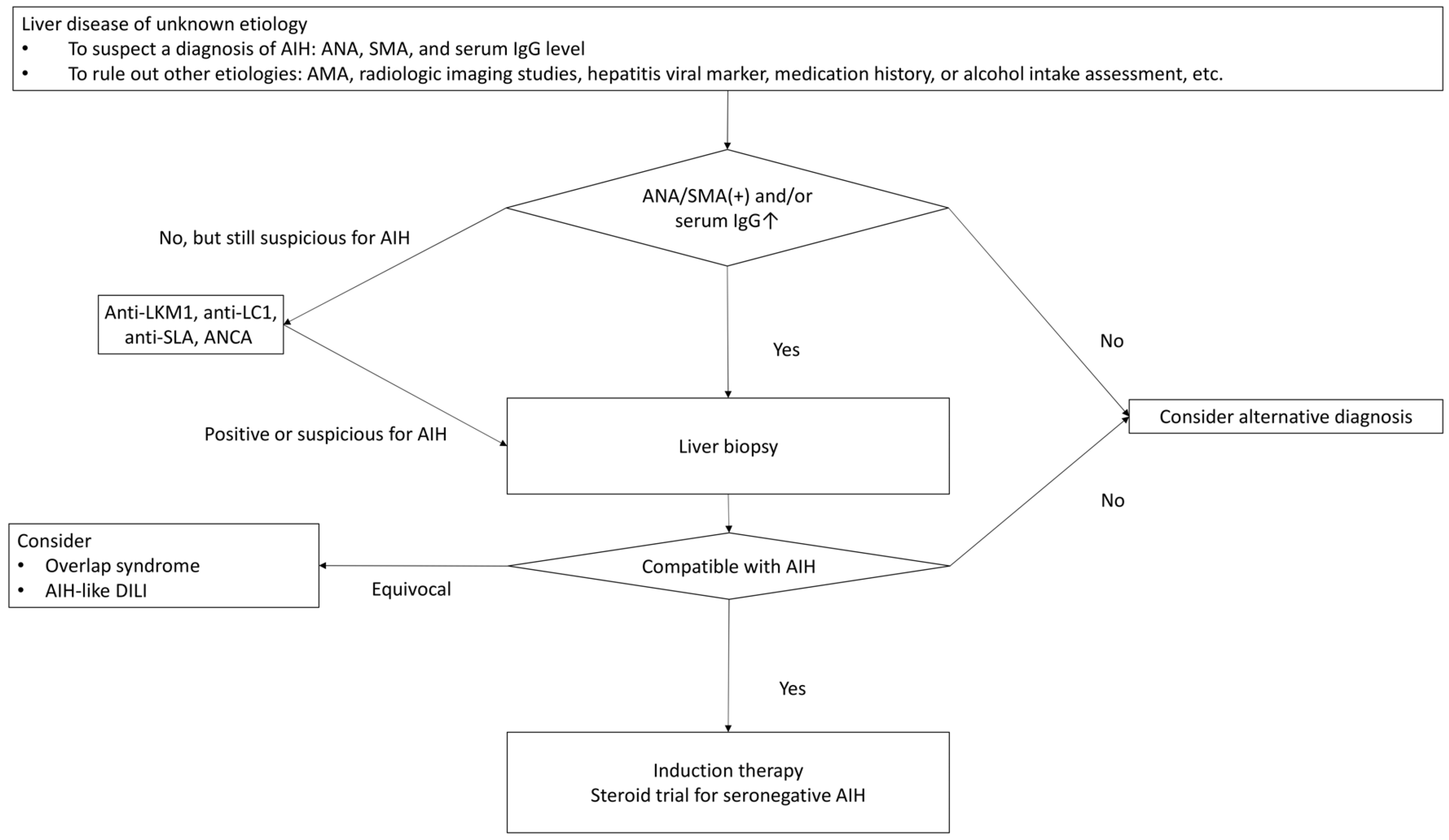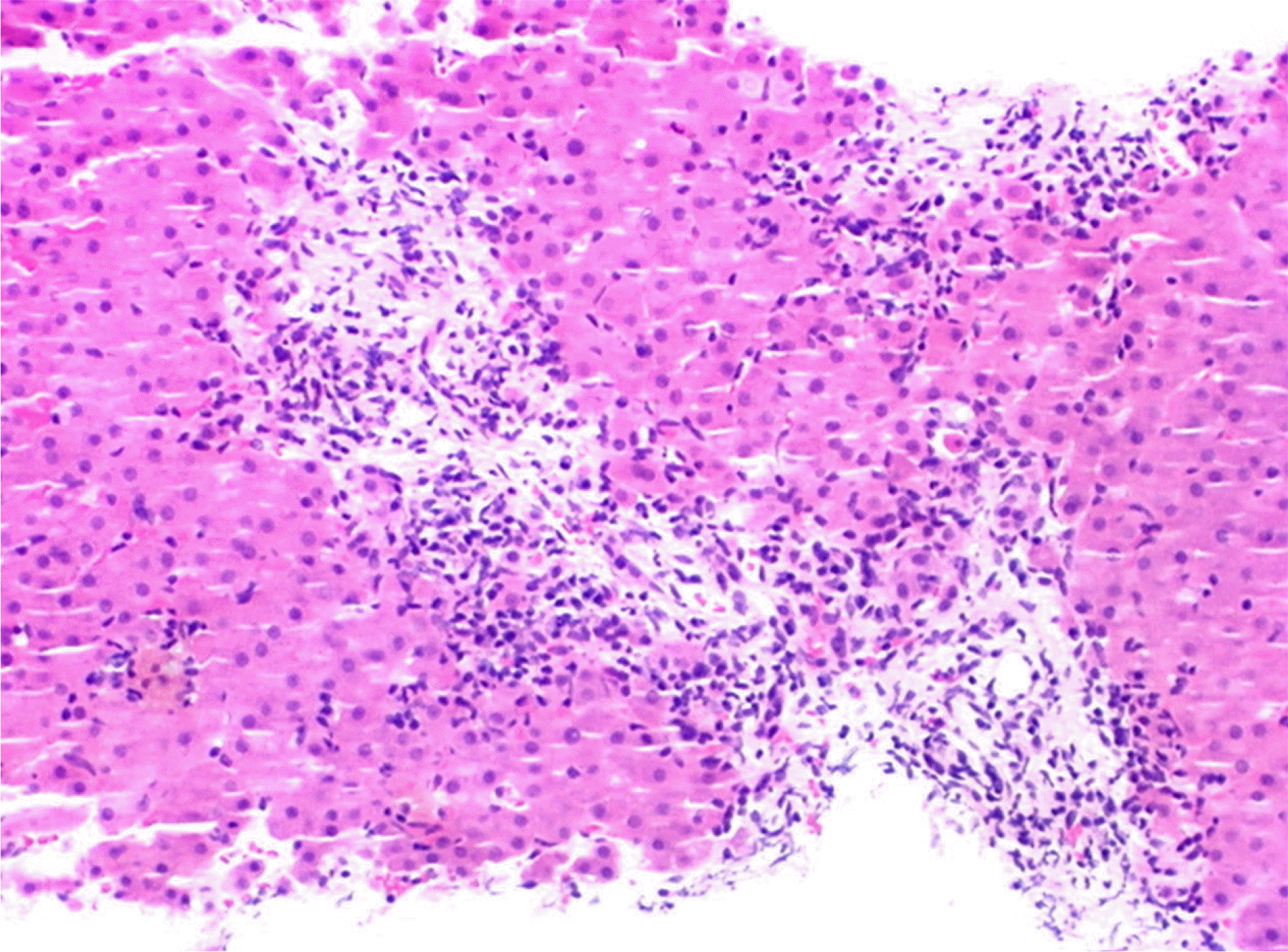1. Mack CL, Adams D, Assis DN, et al. 2020; Diagnosis and management of autoimmune hepatitis in adults and children: 2019 Practice Guidance and Guidelines From the American Association for the Study of Liver Diseases. Hepatology. 72:671–722. DOI:
10.1002/hep.31065. PMID:
31863477.

2. Wang G, Tanaka A, Zhao H, et al. 2021; The Asian Pacific Association for the Study of the Liver clinical practice guidance: the diagnosis and management of patients with autoimmune hepatitis. Hepatol Int. 15:223–257. DOI:
10.1007/s12072-021-10170-1. PMID:
33942203. PMCID:
PMC8144150.

3. Lim K, Park JG. 2022; Diagnostic approach to autoimmune hepatitis. Korean J Med. 97:33–41. DOI:
10.3904/kjm.2022.97.1.33.

5. Zachou K, Muratori P, Koukoulis GK, et al. 2013; Review article: autoimmune hepatitis -- current management and challenges. Aliment Pharmacol Ther. 38:887–913. DOI:
10.1111/apt.12470. PMID:
24010812.

6. Hennes EM, Zeniya M, Czaja AJ, et al. International Autoimmune Hepatitis Group. Simplified criteria for the diagnosis of autoimmune hepatitis. Hepatology. 2008; 48:169–176. DOI:
10.1002/hep.22322. PMID:
18537184.

7. Fujiwara K, Fukuda Y, Yokosuka O. 2008; Precise histological evaluation of liver biopsy specimen is indispensable for diagnosis and treatment of acute-onset autoimmune hepatitis. J Gastroenterol. 43:951–958. DOI:
10.1007/s00535-008-2254-x. PMID:
19107339.

8. Yasui S, Fujiwara K, Yonemitsu Y, Oda S, Nakano M, Yokosuka O. 2011; Clinicopathological features of severe and fulminant forms of autoimmune hepatitis. J Gastroenterol. 46:378–390. DOI:
10.1007/s00535-010-0316-3. PMID:
20821236.

9. Laschtowitz A, Zachou K, Lygoura V, et al. 2021; Histological activity despite normal ALT and IgG serum levels in patients with autoimmune hepatitis and cirrhosis. JHEP Rep. 3:100321. DOI:
10.1016/j.jhepr.2021.100321. PMID:
34381983. PMCID:
PMC8333110.

10. Joshita S, Yoshizawa K, Umemura T, et al. Japan Autoimmune Hepatitis Study Group (JAIHSG). Clinical features of autoimmune hepatitis with acute presentation: a Japanese nationwide survey. J Gastroenterol. 2018; 53:1079–1088. DOI:
10.1007/s00535-018-1444-4. PMID:
29476251.

11. Terziroli Beretta-Piccoli B, Mieli-Vergani G, Vergani D. 2022; Autoimmune hepatitis: serum autoantibodies in clinical practice. Clin Rev Allergy Immunol. 63:124–137. DOI:
10.1007/s12016-021-08888-9. PMID:
34491531. PMCID:
PMC9464171.

12. Wies I, Brunner S, Henninger J, et al. 2000; Identification of target antigen for SLA/LP autoantibodies in autoimmune hepatitis. Lancet. 355:1510–1515. DOI:
10.1016/S0140-6736(00)02166-8. PMID:
10801173.

13. European Association for the Study of the Liver. 2015; EASL Clinical Practice Guidelines: Autoimmune hepatitis. J Hepatol. 63:971–1004. Erratum in: J Hepatol 2015;63:1543-1544. DOI:
10.1016/j.jhep.2015.09.016.
14. Zachou K, Rigopoulou E, Dalekos GN. 2004; Autoantibodies and autoantigens in autoimmune hepatitis: important tools in clinical practice and to study pathogenesis of the disease. J Autoimmune Dis. 1:2. DOI:
10.1186/1740-2557-1-2. PMID:
15679907. PMCID:
PMC544946.
15. Targan SR, Landers C, Vidrich A, Czaja AJ. 1995; High-titer antineutrophil cytoplasmic antibodies in type-1 autoimmune hepatitis. Gastroenterology. 108:1159–1166. DOI:
10.1016/0016-5085(95)90215-5. PMID:
7698584.

16. O'Brien C, Joshi S, Feld JJ, Guindi M, Dienes HP, Heathcote EJ. 2008; Long-term follow-up of antimitochondrial antibody-positive autoimmune hepatitis. Hepatology. 48:550–556. DOI:
10.1002/hep.22380. PMID:
18666262.
17. Farias AQ, Gonçalves LL, Bittencourt PL, et al. 2006; Applicability of the IAIHG scoring system to the diagnosis of antimitochondrial/anti-M2 seropositive variant form of autoimmune hepatitis. J Gastroenterol Hepatol. 21:887–893. DOI:
10.1111/j.1440-1746.2006.04130.x. PMID:
16704541.

18. Gassert DJ, Garcia H, Tanaka K, Reinus JF. 2007; Corticosteroid-responsive cryptogenic chronic hepatitis: evidence for seronegative autoimmune hepatitis. Dig Dis Sci. 52:2433–2437. DOI:
10.1007/s10620-006-9665-4. PMID:
17429719.

19. Alvarez F, Berg PA, Bianchi FB, et al. 1999; International Autoimmune Hepatitis Group Report: review of criteria for diagnosis of autoimmune hepatitis. J Hepatol. 31:929–938. DOI:
10.1016/S0168-8278(99)80297-9. PMID:
10580593.

20. Balitzer D, Shafizadeh N, Peters MG, Ferrell LD, Alshak N, Kakar S. 2017; Autoimmune hepatitis: review of histologic features included in the simplified criteria proposed by the international autoimmune hepatitis group and proposal for new histologic criteria. Mod Pathol. 30:773–783. DOI:
10.1038/modpathol.2016.267. PMID:
28106105.

21. Lohse AW, Sebode M, Bhathal PS, et al. 2022; Consensus recommendations for histological criteria of autoimmune hepatitis from the International AIH Pathology Group: Results of a workshop on AIH histology hosted by the European Reference Network on Hepatological Diseases and the European Society of Pathology: Results of a workshop on AIH histology hosted by the European Reference Network on Hepatological Diseases and the European Society of Pathology. Liver Int. 42:1058–1069. DOI:
10.1111/liv.15217. PMID:
35230735.

22. Johnson PJ, McFarlane IG. 1993; Meeting report: International Autoimmune Hepatitis Group. Hepatology. 18:998–1005. DOI:
10.1002/hep.1840180435. PMID:
8406375.

23. Jeong SH. 2018; Current epidemiology and clinical characteristics of autoimmune liver diseases in South Korea. Clin Mol Hepatol. 24:10–19. DOI:
10.3350/cmh.2017.0066. PMID:
29307132. PMCID:
PMC5875193.

24. Czaja AJ. 2008; Performance parameters of the diagnostic scoring systems for autoimmune hepatitis. Hepatology. 48:1540–1548. DOI:
10.1002/hep.22513. PMID:
18924244.

25. Miyake Y, Iwasaki Y, Kobashi H, et al. 2010; Clinical features of autoimmune hepatitis diagnosed based on simplified criteria of the International Autoimmune Hepatitis Group. Dig Liver Dis. 42:210–215. DOI:
10.1016/j.dld.2009.06.013. PMID:
19632907.

26. Kim BH, Kim YJ, Jeong SH, et al. 2013; Clinical features of autoimmune hepatitis and comparison of two diagnostic criteria in Korea: a nationwide, multicenter study. J Gastroenterol Hepatol. 28:128–134. DOI:
10.1111/j.1440-1746.2012.07292.x. PMID:
23033899.

27. Lee YN, Kim YS, Kim SG, et al. 2011; Diagnostic Value and Utility of the Simplified International Autoimmune Hepatitis Group (IAIHG) criteria for autoimmune hepatitis in Korea. Korean J Med. 81:340–350. DOI:
10.3904/kjim.2011.26.3.340. PMID:
22016595. PMCID:
PMC3192207.
28. Kuiper EM, Zondervan PE, van Buuren HR. 2010; Paris criteria are effective in diagnosis of primary biliary cirrhosis and autoimmune hepatitis overlap syndrome. Clin Gastroenterol Hepatol. 8:530–534. DOI:
10.1016/j.cgh.2010.03.004. PMID:
20304098.

29. Chazouillères O, Wendum D, Serfaty L, Montembault S, Rosmorduc O, Poupon R. 1998; Primary biliary cirrhosis-autoimmune hepatitis overlap syndrome: clinical features and response to therapy. Hepatology. 28:296–301. DOI:
10.1002/hep.510280203. PMID:
9695990.

31. Hisamochi A, Kage M, Ide T, et al. 2016; An analysis of drug-induced liver injury, which showed histological findings similar to autoimmune hepatitis. J Gastroenterol. 51:597–607. DOI:
10.1007/s00535-015-1131-7. PMID:
26519284.

33. deLemos AS, Foureau DM, Jacobs C, Ahrens W, Russo MW, Bonkovsky HL. 2014; Drug-induced liver injury with autoimmune features. Semin Liver Dis. 34:194–204. DOI:
10.1055/s-0034-1375959. PMID:
24879983.







 PDF
PDF Citation
Citation Print
Print



 XML Download
XML Download